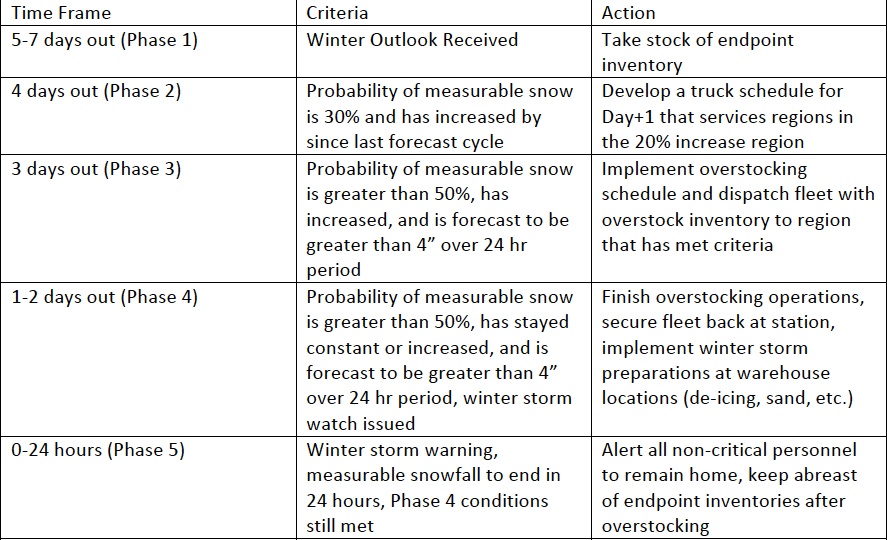A significant winter storm is possible in the next 4 days. How will you handle it?
by Daphne Thompson, on Sep 15, 2015 11:14:36 AM
One of the enduring challenges for the applied meteorological community is to take highly technical information derived from complex physical models, and boil that down into an actionable decision that any operational manager can implement quickly and without hesitation. Sure, I can give you megabytes of information concerning uncertainty in the forecast, but in the end that doesn’t connect information to action. To do so, the front line emergency manager typically has to filter through aforementioned stacks of megabytes to find the critical weather information that they can tie to something their people are supposed to do as a result of the impending conditions. And so, most emergency managers are faced with the daunting task of trying to perfect the art of meteorological translation for the rest of their company.

Let’s look at some object examples. In our first case, you’ve got a supply chain management division that is tightly coupled with little slack in delivery slippage. Any deviation in these schedules will result in the frustrated masses not having their favorite party favors for the upcoming football game, or more seriously, critical supplies that will be needed during periods of impassable weather conditions. So our Division Manager, let’s call him Joe, watches the evening news and finds out that a significant winter storm is being tossed out as a possibility somewhere in the 5 day timeframe. Joe is very aware that 5 days may seem like an eternity to most folks for preparation, but for his division, he is already down to the wire. Three to four days out, they need shipments scheduled to replenish inventories that will be gutted only days from the impending storm. Additionally, they need to keep their drivers out of harm’s way. Imagine the frustration that Joe feels when he has to make this call based on the following fictional guidance 4 days out:
“A significant winter storm is still possible in the next 4 days. However due to track uncertainty and the position of the freezing line, it is difficult to say who might be affected at this time and what form the precipitation will take”
At this point, our under-informed manager has to make some hard decisions with real dollars based upon a very subjective assessment that doesn’t provide much in the way of comfort. Now, the forecast assessment above is probably quite true as any meteorologist worth his salt will tell you that the atmosphere is not a deterministic system and so you must couch forecasts with probabilistic terms. However, Joe our now stressed-out manager has no actionable way to correlate these probabilistic statements with actions he should take. So what gives? Should he begin sending out the trucks with overstock? Of course he does! Because if the worst case happens and he has done nothing, he’s now gone from stressed out Joe to unemployed Joe.
Now think about this case. What if Joe had quality guidance to work with:

As you can see, you now have a natural progression of actionable information tied to clear markers in the weather forecast that is not at the mercy of the latest subjective speculation by the closest weather guru. Of course, to base such critical decision making on a checklist requires that the information behind that checklist be of high quality. Therefore, Joe needs to partner with a good weather source to make such a continuity plan execute as it is intended. However, the mystification of the weather conditions wrapped under a veil of uncertainty is now boiled down to certain trigger points. Sure, you still have uncertainty here in the form of probabilities, but you’ve added tendencies and magnitudes to clear up the picture a bit while also point at clear threshold values.
Is this full-proof? Certainly not! We are talking about an inherently chaotic system here. Eventually however, you will reach a limit in this progression and walk your way back down from the ledge based on the latest data should the storm turn it’s crosshairs towards another location. Additionally, you’ve taken information out of a chaotic system and turned it into actionable systems. In Joe’s eyes, that’s progress, even if the forecast does not completely verify!
Are there other meteorological scenarios that could benefit from such an approach? Consider the marina owner who has to perform multiple operations in advance of an approaching tropical system. Each step becomes more time consuming and labor intensive than the other necessitating a clear picture of what effort really needs to be expended vs. being false alarmed. This tropical guidance is something my parent organization has recently developed for those who find themselves in harm’s way of tropical systems. We call these Risk & Response Reports and they provide a linkage between business continuity phases and tropical weather conditions that a site might experience. We understand that multi-million dollar operations have a lot of inertia and so take time to wind down. Therefore, the marina owner, Port Authority supervisor, or any other decision maker require key decision points tied to evolving weather conditions to assist in their management during potentially dangerous conditions.
In an age where probabilistic forecast data is getting better and better at capturing the range of possible outcomes, it makes complete sense to begin tying these specific outcomes to critical decision points for business continuity operations. Tethering this probabilistic information to other key metrics in the forecast process only serves to add confidence to the actions being taken. I believe that this is an area of untapped potential for weather decision support organizations and one that will only serve to safeguard life and property in an increasing fashion in future years. As an organization, we are embracing this challenge.








